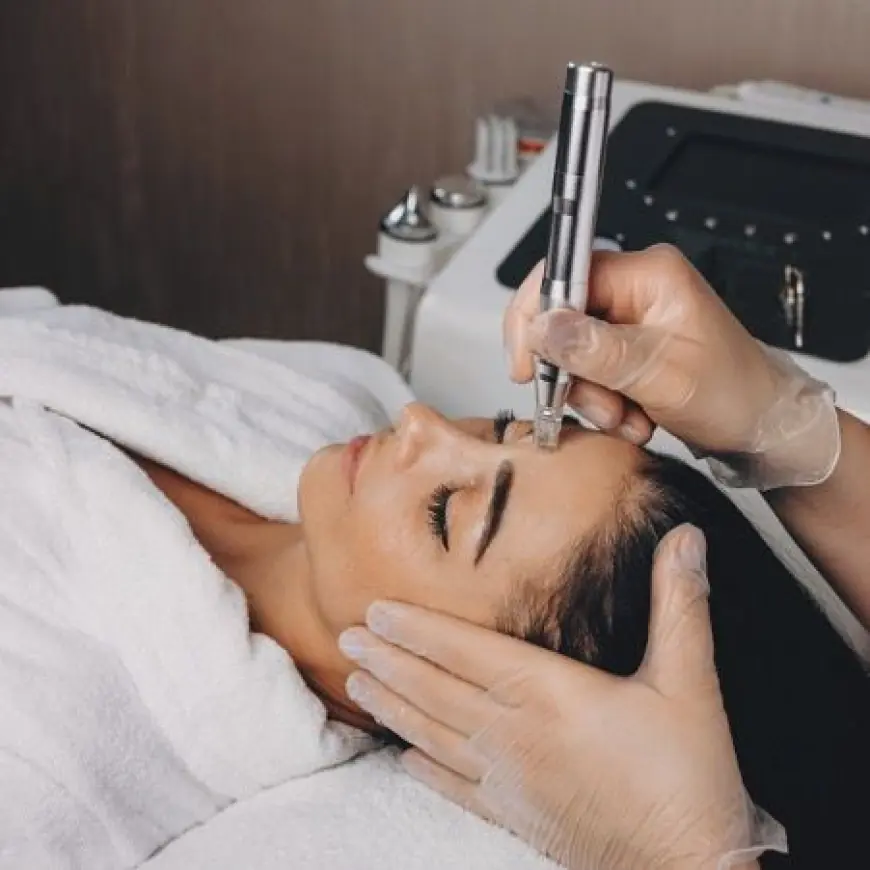Derma Pen for Uneven Skin Tone Help?
The Derma Pen, Jeddah and Saudi Arabia (ديرمابن في الرياض) has emerged as a revolutionary tool in the realm of skin rejuvenation, particularly for addressing uneven skin tone.

Uneven skin tone, characterized by patches of hyperpigmentation (dark spots), sun damage, melasma, or post-inflammatory hyperpigmentation (PIH) from acne or injuries, is a common concern that affects many individuals. It can significantly impact one's confidence and the overall appearance of their complexion. While various topical treatments exist, advancements in aesthetic technology have introduced innovative solutions like the Derma Pen, offering a promising approach to achieving a more uniform and radiant skin tone. Understanding how this device works and its potential benefits is the first step towards a smoother, more even complexion.
What is Uneven Skin Tone?
Uneven skin tone refers to inconsistencies in the color and texture of the skin. This can manifest as dark spots (age spots or sun spots), redness, blotchiness, or areas of hyperpigmentation where excess melanin has been produced. Factors like sun exposure, hormonal fluctuations, inflammation, and genetic predisposition all contribute to these irregularities, making the skin appear dull and less vibrant.
The Quest for Even Skin
The desire for an even, luminous complexion is universal. Many individuals spend considerable time and effort seeking effective solutions to fade dark spots, minimize discoloration, and restore a youthful glow. This pursuit has led to the development of various treatments, from powerful serums to advanced in-clinic procedures, each designed to tackle the complexities of uneven skin tone.
The Derma Pen, Jeddah and Saudi Arabia: A Revolution for Skin Uniformity
The Derma Pen, Jeddah and Saudi Arabia (ديرمابن في الرياض) has emerged as a revolutionary tool in the realm of skin rejuvenation, particularly for addressing uneven skin tone. This advanced microneedling device utilizes a unique mechanism to stimulate the skin's natural healing processes, leading to a visible improvement in complexion uniformity and overall skin health. Understanding its science helps demystify its effectiveness.
How Does the Derma Pen Work?
The Derma Pen is an automated microneedling device that features a tip with multiple fine, sterile needles. When moved across the skin, these needles create thousands of microscopic punctures in the epidermis and dermis, often referred to as "micro-injuries" or "micro-channels." These controlled injuries are tiny and typically close within hours, but they trigger a cascade of beneficial responses within the skin:
-
Collagen and Elastin Induction: The body interprets these micro-injuries as damage and initiates its natural wound-healing process. This involves the increased production of collagen and elastin, two vital proteins responsible for skin firmness, elasticity, and overall structural integrity. New, healthy collagen helps to plump the skin and fill in areas of discoloration.
-
Enhanced Product Absorption: The micro-channels created by the Derma Pen act as pathways, significantly increasing the absorption of topical serums, active ingredients, and brightening agents applied to the skin. This allows these products to penetrate deeper into the skin layers where they can work more effectively to address pigmentation issues.
-
Cell Turnover and Melanin Regulation: The microneedling process encourages cell turnover, promoting the shedding of old, pigmented skin cells and the generation of fresh, new cells. This helps to break up melanin clusters that contribute to dark spots and encourages a more even distribution of pigment, leading to a more uniform skin tone.
Targeting Different Types of Pigmentation
The versatility of the Derma Pen allows it to target various forms of uneven skin tone:
-
Hyperpigmentation and Sun Spots: By stimulating cell turnover and promoting the natural shedding of pigmented cells, the Derma Pen can significantly lighten dark spots caused by sun exposure.
-
Melasma: While melasma can be challenging to treat, the Derma Pen, especially when combined with appropriate topical solutions, can help to break down existing melanin and regulate future pigment production, leading to a more even complexion.
-
Post-Inflammatory Hyperpigmentation (PIH): PIH, often left behind after acne breakouts or skin injuries, responds well to Derma Pen treatments. The collagen induction helps to remodel the skin, reducing the appearance of these lingering dark marks.
Preparing for Your Derma Pen Session: What You Need to Know
Proper preparation is essential for maximizing the benefits of your Derma Pen treatment and ensuring a smooth, effective experience. Whether you're seeking a professional treatment or considering an at-home device, understanding the pre-treatment guidelines is crucial.
Pre-Treatment Consultation and Skin Assessment
Before any Derma Pen session, particularly for professional treatments, a thorough consultation with a skincare specialist is paramount. During this consultation, the specialist will:
-
Assess Your Skin: Evaluate your skin type, current condition, and the specific concerns contributing to your uneven skin tone. This helps determine the appropriate needle depth and treatment plan.
-
Review Medical History: Discuss any underlying medical conditions, medications you are taking (especially blood thinners or retinoids), and any history of cold sores or keloid scarring.
-
Set Realistic Expectations: Clearly explain the potential results, the number of sessions required, and the recovery process.
-
Provide Pre-Care Instructions: Advise on steps to take leading up to your appointment, such as avoiding sun exposure, discontinuing certain skincare products (e.g., retinoids, harsh exfoliants) for a few days to a week prior, and ensuring your skin is clean and free of active breakouts.
Choosing the Right Needle Depth and Serums
The effectiveness of a Derma Pen treatment for uneven skin tone is greatly influenced by the appropriate needle depth and the complementary serums used.
-
Needle Depth: For uneven skin tone and pigmentation, professional treatments might use needle depths ranging from 0.5mm to 1.5mm, depending on the severity of the pigmentation and the area being treated. Deeper penetration targets more stubborn discoloration. For at-home use, much shallower depths (typically 0.2mm to 0.25mm) are recommended for safety, primarily for enhancing serum absorption.
-
Topical Serums: Serums play a vital role, as the micro-channels allow for superior absorption. For uneven skin tone, beneficial serums include:
-
Vitamin C: A powerful antioxidant known for its brightening properties and ability to inhibit melanin production.
-
Niacinamide (Vitamin B3): Helps reduce inflammation, improve skin barrier function, and inhibit melanosome transfer, leading to lighter pigmentation.
-
Hyaluronic Acid: Provides intense hydration, which is crucial for healing and overall skin health.
-
Growth Factors and Peptides: Support collagen production and accelerate skin repair, leading to healthier, more even-toned skin.
-
Licorice Root Extract or Kojic Acid: Natural skin lighteners that help reduce hyperpigmentation.
-
Your specialist will recommend the most suitable serums to use during and after your Derma Pen treatment to optimize results for your specific concerns.
Aftercare and Expected Results: Your Journey to Luminous Skin
The success of a Derma Pen treatment for uneven skin tone doesn't end with the session itself; proper aftercare is crucial for maximizing benefits and ensuring optimal healing. Understanding what to expect during the recovery period and how to maintain your results is key to achieving your desired luminous complexion.
Immediate Post-Treatment Care
Immediately after a Derma Pen session, your skin will likely appear red, similar to a sunburn, and may feel warm, tight, or slightly swollen. This is a normal and expected response as your skin's natural healing process kicks in.
-
Gentle Cleansing: Use a very mild, non-foaming cleanser with lukewarm water for the first 24-48 hours.
-
Hydration: Apply a gentle, non-irritating, hydrating serum (like hyaluronic acid) and a soothing, oil-free moisturizer to keep the skin comfortable and prevent dryness.
-
Avoid Irritants: Steer clear of harsh skincare products, retinoids, AHAs, BHAs, and direct sun exposure for at least 3-7 days, or as advised by your specialist.
-
Sun Protection: This is paramount. Apply a broad-spectrum sunscreen with SPF 30 or higher religiously every day, even indoors, as the new skin is highly sensitive to UV damage, which can worsen pigmentation.
-
Makeup: Avoid makeup for at least 24 hours to allow the micro-channels to close and prevent irritation or infection.
Long-Term Aftercare and Maintenance
Maintaining your results requires a consistent skincare routine and ongoing protection.
-
Daily Sun Protection: Continue to use high-quality sunscreen daily. Sun exposure is the leading cause of uneven skin tone.
-
Targeted Skincare: Incorporate serums with brightening ingredients (Vitamin C, Niacinamide) and gentle exfoliants (once healing is complete) into your routine to support cell turnover and maintain even tone.
-
Hydration: Keep your skin well-hydrated to support overall skin health and barrier function.
-
Follow-Up Sessions: Multiple Derma Pen sessions, typically spaced 4-6 weeks apart, are usually recommended for optimal and lasting results. Your specialist will advise on the ideal treatment plan.
When Will You See Results?
While some patients may notice an immediate glow and improved texture after a single session due to increased blood flow and hydration, the significant improvement in uneven skin tone often appears gradually over several weeks and months. This is because collagen remodeling and melanin regulation are slow processes. Best results are typically observed after a series of 3-6 treatments, with continued improvement for months after the final session as the skin continues to regenerate. The transformative potential of the Derma Pen, Jeddah and Saudi Arabia is truly realized with consistent application and dedicated aftercare.
Frequently Asked Questions
Understanding how the Derma Pen specifically targets uneven skin tone can help address common concerns and clarify expectations. Here are some key questions answered:
Many People Inquire: Is Derma Pen effective for all types of uneven skin tone?
While the Derma Pen is highly effective for many forms of uneven skin tone, particularly hyperpigmentation, sun spots, and post-inflammatory hyperpigmentation, its efficacy can vary for certain conditions like deep-seated melasma. For some severe cases, a combination approach with other treatments (e.g., specific topical medications, or other light-based therapies) might be recommended for optimal results. A thorough consultation with a skincare professional will determine the most suitable treatment plan for your specific type of uneven skin tone.
Often Wondered: How many Derma Pen sessions are typically needed to see improvement in uneven skin tone?
The number of Derma Pen sessions required for noticeable improvement in uneven skin tone varies based on the severity of the pigmentation, the individual's skin response, and the depth of the treatment. Generally, a series of 3 to 6 sessions, spaced approximately 4 to 6 weeks apart, is recommended. Significant improvements often become visible after the third session, with continued enhancement as new collagen forms and pigmented cells are shed. Maintenance sessions may also be advised to prolong the results.
People Also Ask: Can a Derma Pen make my uneven skin tone worse?
When performed correctly by a trained professional or used safely at home with proper guidelines, a Derma Pen should not worsen uneven skin tone. In fact, it's designed to improve it. However, improper use, such as using incorrect needle depth, unsanitary practices, or neglecting sun protection during the healing phase, can lead to complications like post-inflammatory hyperpigmentation (darkening of the skin), infection, or scarring, which could exacerbate existing unevenness. Adhering to professional advice and aftercare is crucial to avoid such adverse effects.
Frequently Asked: What kind of serums should I prioritize for uneven skin tone when using a Derma Pen?
For addressing uneven skin tone with a Derma Pen, prioritize serums that contain active ingredients known for their brightening and melanin-inhibiting properties, as well as those that promote healing and hydration. Key ingredients to look for include: Vitamin C (a powerful antioxidant and brightener), Niacinamide (Vitamin B3, which helps with barrier function and reduces pigment transfer), Hyaluronic Acid (for essential hydration and healing), and possibly gentle lightening agents like licorice root extract or alpha arbutin. Always ensure the serums are sterile and suitable for microneedling to prevent irritation.
What's Your Reaction?
 Like
0
Like
0
 Dislike
0
Dislike
0
 Love
0
Love
0
 Funny
0
Funny
0
 Angry
0
Angry
0
 Sad
0
Sad
0
 Wow
0
Wow
0



















































